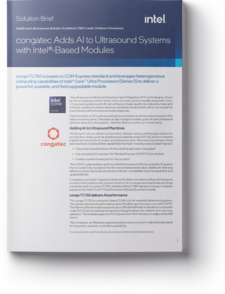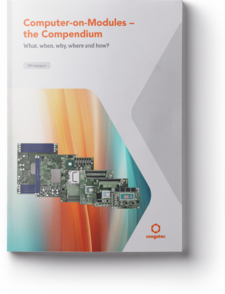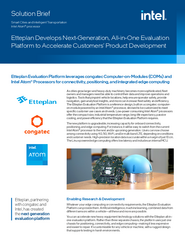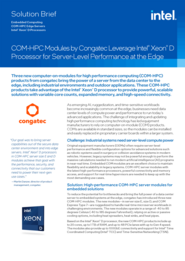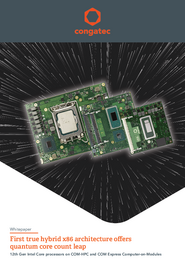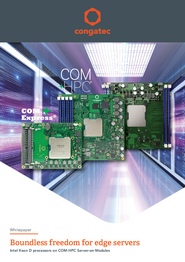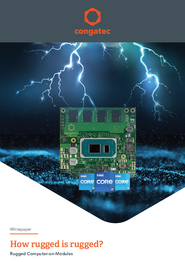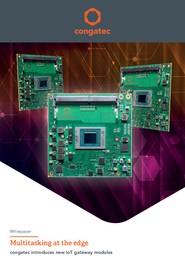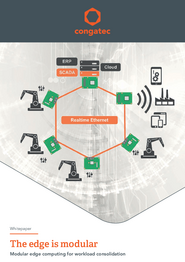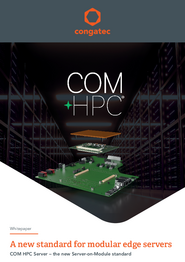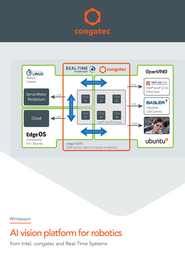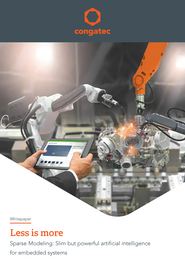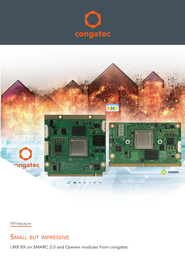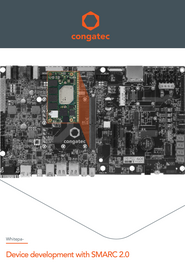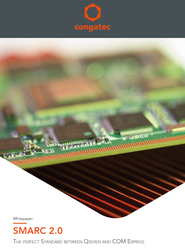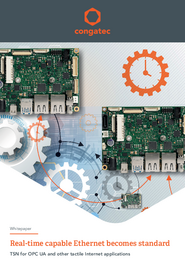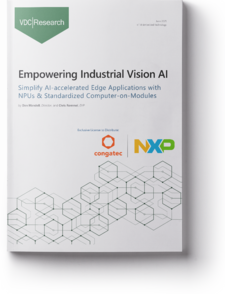
Empowering Industrial Vision AI
The powerful combination of vision-based technologies and edge AI promises major gains in efficiency, security, and safety. But designing these solutions requires specialized expertise. Discover key trends, challenges, and the evolution of development platforms in this in-depth study by VDC Research.


NPU-Accelerated Edge Vision
Embedded vision integration is critical to the success of AI-enabled systems, whether in AMRs, AGVs, quality inspection systems, or collaborative robotics. Preconfigured embedded hardware and software vision building blocks make it easy for developers to quickly create custom solutions.


Wireless TSN
Wireless Time Sensitive Networking (WTSN) enables deterministic, low-latency communication and real-time synchronization over standard Wi-Fi Ethernet extending real-time communication to autonomous and mobile applications. The first standardized modules are already simplifying the design-in of this upcoming standard.


Introduction to workload consolidation
Leveraging multicore processors and virtualization, you can consolidate multiple tasks onto a single platform, where each task operates securely and independently from each other. This is an effective way to reduce costs and complexity in embedded applications.


How to design robotic brains
The economic value of the industrial robotics market is growing rapidly and is expected to reach $US 214.60 billion, with a 22.80% compound annual growth rate (CAGR) by 2030. This will be driven, in part, by the integration of new technologies like artificial intelligence (AI), which is expected to contribute $US 44.5 billion to this figure.


Adapting industrial edge servers to evolving markets
Data processing is surging in sectors like manufacturing, energy, and smart cities, creating a booming market for edge servers. According to Global Market Insights, this will create a $29 billion opportunity for near- and far-edge computing solutions by 2025


System consolidation in autonomous mobile robots
Software functions define the capabilities of autonomous robots. Consolidating all functions on one system can help to make your designs more powerful, cost effective, and resilient. Learn what is possible and what to consider in our whitepaper.
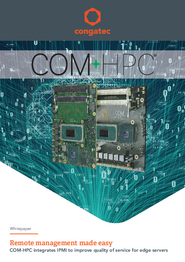
Remote management made easy
COM-HPC is defines an interface specification for the out-of-band management of embedded system platforms. OEMs benefit from the ability to remotely monitor systems, install updates and patches, and resolve issues remotely without being physically present in the server room.

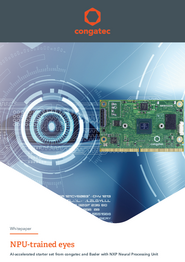
NPU-trained eyes
Embedded vision integration is critical to the success of AI-enabled systems, whether in self-driving vehicles, video surveillance, or collaborative robotics. Preconfigured embedded vision building blocks make it easy for developers to quickly create custom solutions. Read the full story here.


Maximum performance for COM Express Type 7 servers
Embedded edge servers and microservers need high performance. Anyone wanting to develop such high-performance systems scalably with server-on-modules for harsh environments needs an ecosystem based on COM Express Type 7 with fanless support for TDPs of up to 100 W.

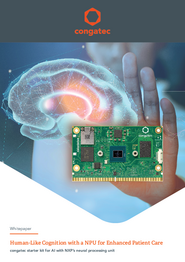
Human-Like Cognition with a NPU for Enhanced Patient Care
The way in which embedded integration is realized determines the success of AI-based systems in biomedical engineering applications – whether for diagnoses, defibrillators, or live images from minimally invasive surgery. Preconfigured embedded modules help developers find specific solutions for medical applications faster.

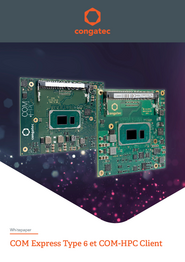
COM Express Type 6 et COM-HPC Client
Pour la première fois depuis de nombreuses années, des processeurs embarqués haut de gamme sont disponibles sur deux formats de Computer-on-Module, COM-HPC® Client et COM Express® Type 6. L’arrivée des processeurs Intel® Core® de 11e génération (nom de code Tiger Lake) offre aux développeurs la possibilité de décider quel format correspond le mieux aux exigences de leur projet.
Download Whitepaper

SMARC modules with NXP i.MX 8M Plus Processor
congatec is expanding its SMARC platform with a new module with an NXP i.MX 8M Plus processor especially for embedded AI applications. Thanks to the extensive ecosystem with application-ready 3.5-inch carrier board, Basler cameras, and AI software stack, fast proof of concept is possible.


Embedded server modules for edge data centers
The growing need to lower latency and reduce energy-hungry data traffic over long distances is leading to rapidly rising deployment of server technology and data centers at the edge. Server-on-Modules based on the COM-HPC and COM Express standards offer a highly efficient design basis for this.

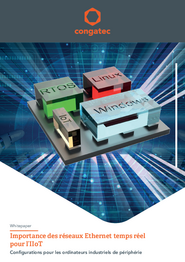
Importance des réseaux Ethernet temps réel pour l’IIoT
Avec l’émergence des technologies 5G et l’arrivée des réseaux GbE 10+ dans le secteur industriel, le traitement en temps réel tirant parti des réseaux sensibles au temps dans les environnements Internet tactile est en train de devenir un nouveau domaine d’application important. Quelles sont les exigences requises pour les ordinateurs de périphérie compatibles TSN?
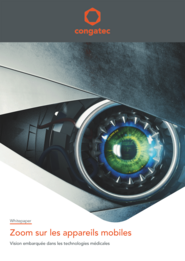
Zoom sur les appareils mobiles
La technologie vidéo en couleur associée à l’intelligence artificielle est un vaste domaine de
développement pour l’optimisation future des soins aux patients. Les systèmes mobiles ont
un rôle important à jouer dans ce contexte, et les OEM ont besoin de solutions qui intègrent
la vision et la technologie informatique embarquées.
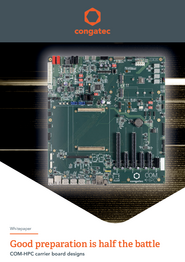
Conception des cartes porteuses COM-HPC
COM-HPC est la nouvelle norme à venir pour les serveurs périphériques modulaires haut de gamme. Il offre des interfaces nettement plus rapides et presque deux fois plus nombreuses que COM Express. Par conséquent, les exigences de conception des cartes porteuses augmentent fortement. Comment les développeurs se préparent à relever ces nouveaux défis ?
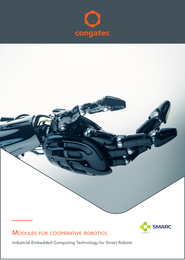
Modules for cooperative robotics
The Service Robotics Research Center of Ulm University of Applied Sciences is developing
a modular software framework to make it easier to program robots. The goal is to provide
software components that can be used universally, for instance to swap robotic gripping
arms from different manufacturers as required to generate new robotics solutions via
plug and play.


De gros gains de performances pour les environnements hostiles
Les processeurs pour serveurs deviennent de plus en plus efficaces sur le plan énergétique. Les développeurs d’applications embarquées les utilisent pour améliorer les performances, ce qui leur ouvre également des champs d’application totalement nouveaux.
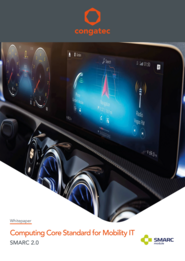
Computing Core Standard for Mobility IT
In the past, electronic components were tailored to specific automotive platforms in order to reduce costs in series production. But in the cockpits of tomorrow, the days of proprietary controller platforms for dedicated functions are over; the future lies in clustering individual mobility functions by using universally applicable computing cores.

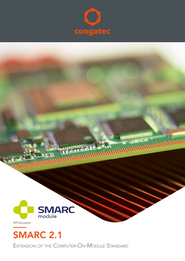
SMARC 2.1 Whitepaper
SMARC 2.0 modules stand out with their rich choice of graphics, camera, sound, network and optional wireless interfaces. The updated specification SMARC 2.1 extends this feature set even further. Two PCI Express lanes can be used alternatively as additional Ethernet ports. Extra two MIPI CSI interfaces and additional GPIOs also extends the possibilities of SMARC modules.



